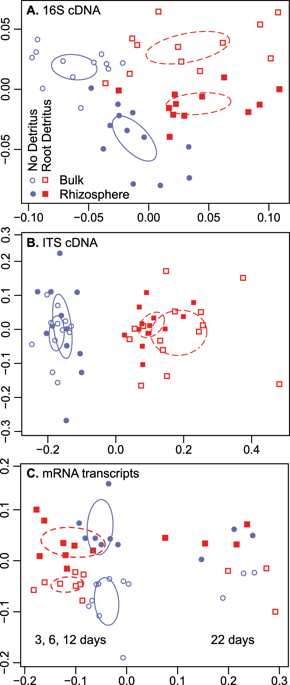Our official English website, www.x-mol.net, welcomes your feedback! (Note: you will need to create a separate account there.)
Niche differentiation is spatially and temporally regulated in the rhizosphere.
The ISME Journal ( IF 11.0 ) Pub Date : 2020-01-17 , DOI: 10.1038/s41396-019-0582-x Erin E Nuccio 1 , Evan Starr 2 , Ulas Karaoz 3 , Eoin L Brodie 3, 4 , Jizhong Zhou 3, 5, 6 , Susannah G Tringe 7 , Rex R Malmstrom 7 , Tanja Woyke 7 , Jillian F Banfield 3, 4 , Mary K Firestone 3, 4 , Jennifer Pett-Ridge 1
The ISME Journal ( IF 11.0 ) Pub Date : 2020-01-17 , DOI: 10.1038/s41396-019-0582-x Erin E Nuccio 1 , Evan Starr 2 , Ulas Karaoz 3 , Eoin L Brodie 3, 4 , Jizhong Zhou 3, 5, 6 , Susannah G Tringe 7 , Rex R Malmstrom 7 , Tanja Woyke 7 , Jillian F Banfield 3, 4 , Mary K Firestone 3, 4 , Jennifer Pett-Ridge 1
Affiliation

|
The rhizosphere is a hotspot for microbial carbon transformations, and is the entry point for root polysaccharides and polymeric carbohydrates that are important precursors to soil organic matter (SOM). However, the ecological mechanisms that underpin rhizosphere carbohydrate depolymerization are poorly understood. Using Avena fatua, a common annual grass, we analyzed time-resolved metatranscriptomes to compare microbial functions in rhizosphere, detritusphere, and combined rhizosphere-detritusphere habitats. Transcripts were binned using a unique reference database generated from soil isolate genomes, single-cell amplified genomes, metagenomes, and stable isotope probing metagenomes. While soil habitat significantly affected both community composition and overall gene expression, the succession of microbial functions occurred at a faster time scale than compositional changes. Using hierarchical clustering of upregulated decomposition genes, we identified four distinct microbial guilds populated by taxa whose functional succession patterns suggest specialization for substrates provided by fresh growing roots, decaying root detritus, the combination of live and decaying root biomass, or aging root material. Carbohydrate depolymerization genes were consistently upregulated in the rhizosphere, and both taxonomic and functional diversity were highest in the combined rhizosphere-detritusphere, suggesting coexistence of rhizosphere guilds is facilitated by niche differentiation. Metatranscriptome-defined guilds provide a framework to model rhizosphere succession and its consequences for soil carbon cycling.
中文翻译:

生态位的分化在根际上在空间和时间上受到调节。
根际是微生物碳转化的热点,并且是根多糖和聚合物碳水化合物的切入点,它们是土壤有机质(SOM)的重要前体。但是,对根际碳水化合物解聚的生态机制了解甚少。我们使用一种常见的一年生草Avena fatua,分析了时间分辨的转录组,比较了根际,碎屑层和根际-碎屑层生境中的微生物功能。使用从土壤分离物基因组,单细胞扩增基因组,元基因组和稳定同位素探测元基因组生成的独特参考数据库对转录物进行分箱。虽然土壤栖息地显着影响了群落组成和整体基因表达,微生物功能的继承发生在比成分变化更快的时间尺度上。使用上调分解基因的层次聚类,我们鉴定了四个不同种类的微生物公会,这些公会由分类群组成,其功能演替模式表明专门针对由新鲜生长的根,腐烂的根碎屑,活的和腐烂的根生物量的组合或衰老的根材料提供的底物。碳水化合物解聚基因在根际中一直被上调,并且在组合的根际-碎屑层中分类学和功能多样性最高,表明利基分化促进了根际行会的共存。转录组定义的行会提供了一个框架,用于模拟根际圈演替及其对土壤碳循环的影响。
更新日期:2020-01-17
中文翻译:

生态位的分化在根际上在空间和时间上受到调节。
根际是微生物碳转化的热点,并且是根多糖和聚合物碳水化合物的切入点,它们是土壤有机质(SOM)的重要前体。但是,对根际碳水化合物解聚的生态机制了解甚少。我们使用一种常见的一年生草Avena fatua,分析了时间分辨的转录组,比较了根际,碎屑层和根际-碎屑层生境中的微生物功能。使用从土壤分离物基因组,单细胞扩增基因组,元基因组和稳定同位素探测元基因组生成的独特参考数据库对转录物进行分箱。虽然土壤栖息地显着影响了群落组成和整体基因表达,微生物功能的继承发生在比成分变化更快的时间尺度上。使用上调分解基因的层次聚类,我们鉴定了四个不同种类的微生物公会,这些公会由分类群组成,其功能演替模式表明专门针对由新鲜生长的根,腐烂的根碎屑,活的和腐烂的根生物量的组合或衰老的根材料提供的底物。碳水化合物解聚基因在根际中一直被上调,并且在组合的根际-碎屑层中分类学和功能多样性最高,表明利基分化促进了根际行会的共存。转录组定义的行会提供了一个框架,用于模拟根际圈演替及其对土壤碳循环的影响。

























 京公网安备 11010802027423号
京公网安备 11010802027423号